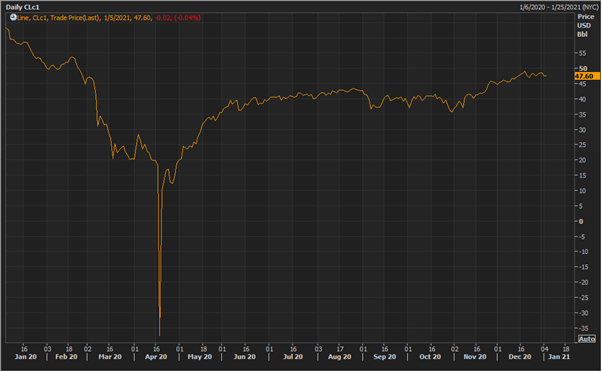Summary
- Precious metals rallied to multi-year highs, while industrial metals recovered substantially in 2020.
- Energy-related commodities, which experienced lower demand, offer an opportunity for the upcoming period when the demand grows back to the pre-COVID levels.
- As per the US EIA, demand and supply for crude oil is forecast to increase to 98.16 and 97.42 mbpd in 2021, respectively.
2020 was the year of commodities. The broad segments of industrial, precious and energy commodities witnessed the consumption-demand shock, on the back of widespread lockdown measures and reduced industrial activities during the year.
The price of precious metals including gold, silver and platinum rallied to multi-year highs. However, energy commodities including crude oil, coal and natural gas plummeted to unprecedented levels.
Pandemic Impact on Commodity Classes
Given the increased volatility in equity markets, many investors turned their focus to safe haven assets, especially gold and silver. The stimulus packages, focused on rebuilding the economies and boosting the industrial activities, aided in creating a sustained demand for industrial commodities.
Though the easing of lockdown restrictions led to some recovery in demand for energy commodities, there is still a long way to reach the pre-pandemic levels. The optimism around the rollout of COVID-19 vaccines is expected to provide support to energy-related commodities including crude oil, coal and natural gas.

The MSCI Industrial Metals Index, which primarily tracks the prices of copper, nickel, aluminium, and others, delivered gains of more than 20% during 2020, in line with the returns from precious metals. The S&P GSCI (the first major investable commodity index), which includes the agricultural and energy-related commodities, also traded in negative for 2020.
Read Here: Iron Ore Prices Continue to Inch up, ASX Metals and Mining Stocks Rejoice
Given this backdrop, let us skim through the worst commodities for 2020 that may have enough fuel to resurge in the upcoming period.
Crude Oil
The pandemic took the crude oil market by surprise, further worsening the prevailing oversupply situation. During the year, the largest commodity slumped to its lowest-ever levels. The WTI crude oil benchmark reached negative levels in April 2020 on the back of shortage of storage and absence of buyers.
The OPEC+ members were proactive enough to react to the declining prices, cutting down the oil supply by approximately 9.5 mbpd to support oil prices. The production cut continued during the latter part of 2020, in order to address the oversupply issue.
The easing of lockdown restrictions has supported the oil prices; however, the demand has still a long way to surge to the earlier levels.
Important Read: More drilling rigs now operational in the US as crude oil price surges
The US EIA has estimated crude oil supply to increase to 97.42 mbpd in 2021. The demand for crude oil has been forecast to rise by 6.2% against 2020 to 98.16 mbpd. The supply-demand balance is expected to keep the oil prices in check while the demand growth may lead to a bull run in crude oil prices.
OPEC+ has decided to limit the increase in crude oil production to 0.5 mbpd for January 2021, down from the earlier anticipated 2 mbpd.

WTI Crude Oil Benchmark (Source: Eikon Refinitiv)
The vaccine rollout and strict compliance of production cuts by OPEC+ members have supported the oil prices. The WTI crude oil benchmark 1-month future traded at US$47.6 a barrel on 31 December 2020, over 20% lower than the prices at the beginning of 2020.
Coal
Coal is a carbon-rich mineral that has been predominantly fuelling the steel and power generation industries, globally. However, the pandemic has altered the entire demand-supply scenario for the mineral that deserves closer attention.
Must Read: Whitehaven Coal Limited’s (ASX:WHC) Investors on a Roller Coaster Ride
The COVID-19 crisis has thrown the economies out of gear, disrupting production facilities across several regions such as Colombia. However, the strong recovery from the Chinese steel mills has provided some respite to the falling metallurgical coal prices.
The stimulus packages towards rebuilding the global infrastructure have also boosted the long-term anticipation of steel demand. The global steel production surged to 158.3 million tonnes in November 2020 following strong growth from China, as reported by the World Steel Association.
Furthermore, ban on the import of Australian coal by China has taken the miners by surprise. As of now, China has been experiencing severe shortages of coal and may need to look for other major coal importers.
The investment trends across thermal coal seem to be dismal, while renewable energy ventures are witnessing a growing interest. Moreover, financial firms have been facing immense pressure from shareholders and climate groups against their coal investments.
Read Here: Indonesia Coal Production Falls Short of Target at 514.2 Million tonnes
As per the December 2020 edition of the Australian Energy and Resources Quarterly report, the price of Australian hard coking coal was expected to average at US$125 a tonne in 2020, decreasing substantially from the 2019 average price levels of US$179 a tonne.



